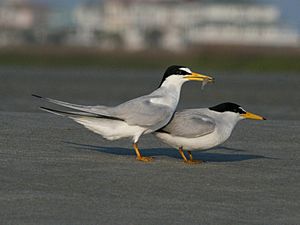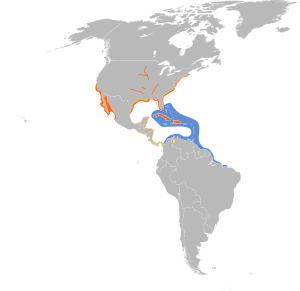Least tern facts for kids
Quick facts for kids Least tern |
|
|---|---|
 |
|
| Conservation status | |
| Scientific classification | |
| Genus: |
Sternula
|
| Species: |
antillarum
|
 |
|
| Synonyms | |
|
Sterna antillarum |
|
The least tern (Sternula antillarum) is a small bird that lives near water. It is a type of tern, which is a seabird. These birds breed in North America and parts of northern South America.
The least tern is related to the little tern found in other parts of the world. It also has relatives like the yellow-billed tern and Peruvian tern from South America.
This tern is quite small. It is about 22 to 24 centimeters (9 to 9.5 inches) long. Its wingspan is about 50 centimeters (20 inches). It weighs between 39 and 52 grams (1.4 to 1.8 ounces).
Its upper body is light gray, and its belly is white. The head is white with a black cap and a black line through its eye. It has a small white patch on its forehead. In winter, this white patch gets bigger.
The bill is yellow with a black tip in summer. In winter, the bill turns mostly black. Its legs are yellowish. The wings are light gray with black marks on the outer feathers. When it flies, it has quick, jerky wingbeats. It often looks a bit hunched over with its bill pointing down.
Least terns are migratory birds. This means they travel long distances. They spend their winters in Central America, the Caribbean, and northern South America. Some young birds stay in their winter homes for their whole first year. Very rarely, one might even fly to Europe.
You can tell a least tern from a little tern because its tail is gray, not white. It also makes a different, squeakier sound. It looks different from other terns by its color and bill tip.
Contents
Types of Least Terns
There are three main types, or subspecies, of least terns. They are all very similar.
- S. a. athalassos: This type breeds along rivers like the Arkansas River and Mississippi River. It spends winters in northern Brazil.
- S. a. antillarum: This is the most common type. It breeds along the Atlantic Ocean coast of North America. This includes places from Maine down to Venezuela. It also winters in northern Brazil.
- S. a. browni: This type is also called the California least tern. It breeds along the Pacific Ocean coast. This range goes from central California down to western Mexico. It mostly winters in Central America.
- In 2012, a new type was found nesting on the Big Island of Hawaii.
Least Tern Conservation
The least tern's numbers are watched closely. Each subspecies has its own conservation status.
Atlantic Coast Least Terns
The S. a. antillarum population has about 21,500 pairs. It is not currently considered endangered by the government. However, many states where it breeds consider it threatened. This means it needs protection. Threats include animals that eat their eggs or young. High tides and people using nesting beaches also cause problems.
River Least Terns
The S. a. athalassos population has about 7,000 pairs. It was listed as an endangered subspecies in 1985. This was because its habitat was lost due to dams and other changes to rivers. It was removed from the endangered list on January 13, 2021.
California Least Terns
The S. a. browni population, the California least tern, was listed as endangered in 1972. At that time, there were only about 600 pairs. With careful management, like putting up fences to keep people away, its numbers have grown. Now there are about 4,500 pairs. This is a big increase from 582 pairs in 1974.
Even with more birds, it is still considered an endangered subspecies. It breeds on beaches and bays in southern California and northwestern Mexico. It is still at risk from predators, natural disasters, or people disturbing its nests. Other birds, like the gull-billed tern, can also harm their nesting success.
Nesting and Reproduction
Least terns arrive at their breeding grounds in late April. They build their nests in colonies, but not too close together. They choose places near water that are free from people or predators. These can be marine or river shores, or sandbar islands.
Before nesting, the male and female birds perform a courtship dance. This usually happens on a flat, open area. After they choose a mate, nesting begins in mid-May. It is usually finished by mid-June. Courtship can involve the female following the male's flight. It can also involve the male feeding the female.
Nests are built on bare or lightly vegetated ground near water. They prefer sandy or gravelly spots. In some areas, they even nest on white gravel rooftops. If the ground is hard, they might use a footprint to make a nest.
There might be only a few nests per acre. But in San Diego County, California, over 200 nests per acre have been seen. Usually, a female lays two or three eggs. Sometimes there is one or four. Both parents take turns sitting on the eggs. This incubation period lasts about three weeks. Both parents also care for the young chicks.
Young birds can fly when they are about four weeks old. After the families are formed, groups of birds might gather near lakes close to the coast. Most least terns leave their breeding grounds by the end of August.
-
Batiquitos Lagoon, a place where least terns breed in San Diego County, California.
-
A pair of least terns nesting on the Missouri River in South Dakota.
-
A least tern chasing a much larger black skimmer in North Carolina, United States.
-
A mating pair of least terns at Sunset Beach, North Carolina.
-
A series of photos showing least terns mating, combined into one image. (St. Augustine, Florida)
-
A least tern feeding its chick the first fish at Quintana, Texas.
-
A least tern (S. a. antillarum) at Lake Jackson, Florida.
Feeding and Roosting
Least terns mainly hunt in shallow estuaries and lagoons. These are places where rivers meet the sea. Small fish are plentiful there. The tern hovers in the air until it spots its prey. Then, it dives into the water to catch the fish. It does not go completely underwater.
They often eat small fish like silversides and anchovies. They also eat shiner perch and small crabs. In southern California, adults also eat kelpfish. During El Niño weather events, they have been known to eat insects. Least terns feed in bays, lagoons, and near the shore. They can also fly far out into the open ocean to find food.
Adult least terns do not need much cover. They often rest and nest on open ground. Once chicks are three days old, their parents brood them less often. The chicks then need protection from wind, sun, and predators. In some colonies, Spanish roof tiles are placed for chicks to hide under.
Predators like burrowing owls, gull-billed terns, and American kestrels can disturb colonies. Domestic cats have also been seen preying on them. On inland breeding grounds, coyotes, bobcats, and other animals also hunt least terns.
See also
 In Spanish: Charrancito americano para niños
In Spanish: Charrancito americano para niños















